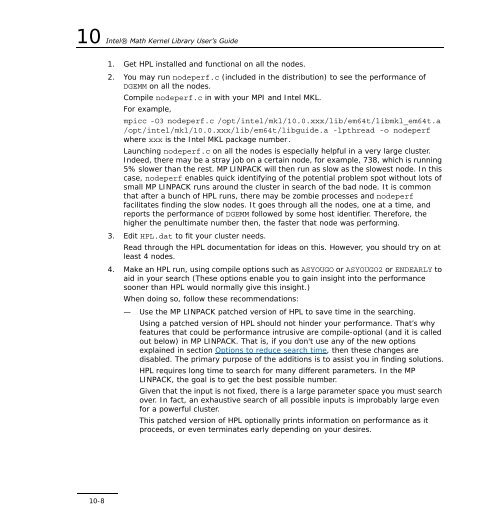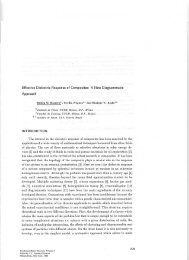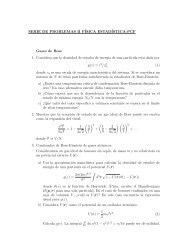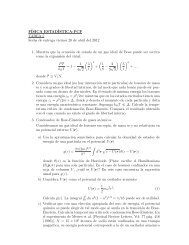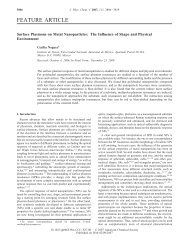Intel(R) - Computational and Systems Biology at MIT
Intel(R) - Computational and Systems Biology at MIT
Intel(R) - Computational and Systems Biology at MIT
You also want an ePaper? Increase the reach of your titles
YUMPU automatically turns print PDFs into web optimized ePapers that Google loves.
10 <strong>Intel</strong>® M<strong>at</strong>h Kernel Library User’s Guide1. Get HPL installed <strong>and</strong> functional on all the nodes.2. You may run nodeperf.c (included in the distribution) to see the performance ofDGEMM on all the nodes.Compile nodeperf.c in with your MPI <strong>and</strong> <strong>Intel</strong> MKL.For example,mpicc -O3 nodeperf.c /opt/intel/mkl/10.0.xxx/lib/em64t/libmkl_em64t.a/opt/intel/mkl/10.0.xxx/lib/em64t/libguide.a -lpthread -o nodeperfwhere xxx is the <strong>Intel</strong> MKL package number.Launching nodeperf.c on all the nodes is especially helpful in a very large cluster.Indeed, there may be a stray job on a certain node, for example, 738, which is running5% slower than the rest. MP LINPACK will then run as slow as the slowest node. In thiscase, nodeperf enables quick identifying of the potential problem spot without lots ofsmall MP LINPACK runs around the cluster in search of the bad node. It is commonth<strong>at</strong> after a bunch of HPL runs, there may be zombie processes <strong>and</strong> nodeperffacilit<strong>at</strong>es finding the slow nodes. It goes through all the nodes, one <strong>at</strong> a time, <strong>and</strong>reports the performance of DGEMM followed by some host identifier. Therefore, thehigher the penultim<strong>at</strong>e number then, the faster th<strong>at</strong> node was performing.3. Edit HPL.d<strong>at</strong> to fit your cluster needs.Read through the HPL document<strong>at</strong>ion for ideas on this. However, you should try on <strong>at</strong>least 4 nodes.4. Make an HPL run, using compile options such as ASYOUGO or ASYOUGO2 or ENDEARLY toaid in your search (These options enable you to gain insight into the performancesooner than HPL would normally give this insight.)When doing so, follow these recommend<strong>at</strong>ions:— Use the MP LINPACK p<strong>at</strong>ched version of HPL to save time in the searching.Using a p<strong>at</strong>ched version of HPL should not hinder your performance. Th<strong>at</strong>’s whyfe<strong>at</strong>ures th<strong>at</strong> could be performance intrusive are compile-optional (<strong>and</strong> it is calledout below) in MP LINPACK. Th<strong>at</strong> is, if you don't use any of the new optionsexplained in section Options to reduce search time, then these changes aredisabled. The primary purpose of the additions is to assist you in finding solutions.HPL requires long time to search for many different parameters. In the MPLINPACK, the goal is to get the best possible number.Given th<strong>at</strong> the input is not fixed, there is a large parameter space you must searchover. In fact, an exhaustive search of all possible inputs is improbably large evenfor a powerful cluster.This p<strong>at</strong>ched version of HPL optionally prints inform<strong>at</strong>ion on performance as itproceeds, or even termin<strong>at</strong>es early depending on your desires.10-8


